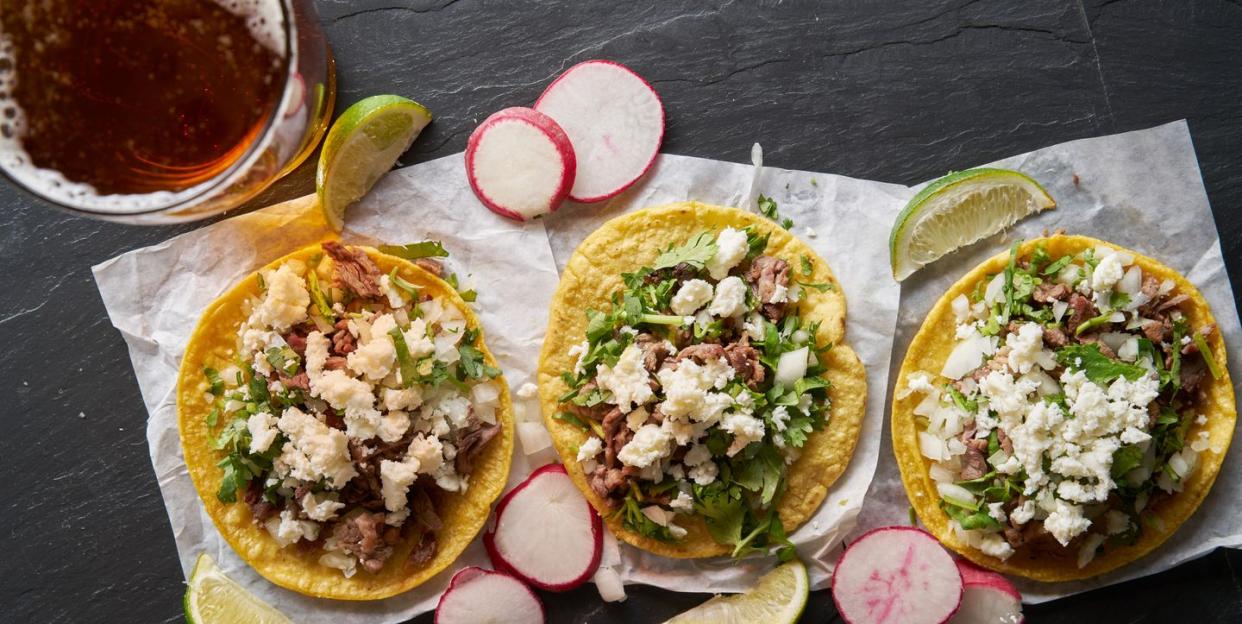The Invention Of Tacos Dates Back To Silver Miners In The 18th Century

As is the case with many popular food dishes, it can be a challenge to pinpoint when in history the meals you know and love today came to be. This is true for tacos, the food with a Mexican origin that has since been Americanized and sold all over the world. Although it's difficult to say when the first taco was invented, there is evidence to support that the name of your favorite finger food dates back to the silver mines of Mexico.
According to University of Toronto Professor of Food History Jeffrey M. Pilcher, the term "taco" can probably be credited to silver miners in the 18th century. In a 2012 interview with Smithsonian Magazine, Pilcher said that the word "taco" is what miners would call the charges used to excavate the silver, which were made from "pieces of paper that they would wrap around gunpowder and insert into the holes they carved in the rock face."
Like many cultural foods, the history of tacos is impacted by colonization and industrialization. When the Spanish invaded Mexico, they looked down on the native foods of the area. Corn was seen as being associated with Native deities but wheat was associated with the Christian eucharist. During this time, native food (Mexican food) was seen as being lower class compared to European food.
Due to these historical contexts and the way different ingredients are native to different areas in Mexico, there are so many different ways tacos can be prepared, Chef Aaron Sanchez told Delish. "Tacos are one of those dishes that are so iconic yet have such a large range of techniques and ingredients from region to region. Even just the difference between flour and corn is so important. Corn is obviously such a big part of Mexican culture and history, and the nixtamalization process in which corn is broken down to make masa is deeply rooted in tradition," he said. "The main components to any taco are a tortilla, a filling, and a salsa. The varieties are virtually endless."
The first mention of tacos in the United States dates back to 1905 in a newspaper, which Pilcher told Smithsonian makes sense because it was around this time that Mexican migrants started to arrive in the states to work jobs in the mines or on the railroads. This shift led to Mexican food being available as street food, with people turning to street vendors to get their fix.
Once tacos made their way to the streets of the United States, it was only a matter of time until they were widespread and eventually became Americanized. The first Taco Bell was opened by Glen Bell in 1962, and made his version of tacos accessible to Americans who didn't want to go to Mexican neighborhoods to try them. The taco shell, which is typically made from a fried tortilla in a "U" shape, was a game-changer for popularizing tacos. Fried tortillas keep longer than fresh ones, so the shells could be made ahead and make preparing the food a more efficient process.
Still, taco shells that are common in grocery stores are more of the vehicle that made tacos more widespread in the States rather than a traditional aspect of Mexican cuisine. "I am from Texas, so I have nothing against hard taco shells, ground beef and yellow shredded cheese but that’s really not Mexican, it’s TexMex," Chef Sanchez explained: "Authentic Mexican tacos use fresh tortillas, flavorful fillings, and a freshly made salsa. Balance is really the key, you want it to be slightly acidic, have some heat, some creaminess, be herbaceous and of course have some delicious protein or vegetables to be the star."
Although there is some gray area in the history of the taco, Pilcher emphasizes that authentic Mexican food has become more widespread in the United States than Americanized Mexican food has become in Mexico. Some Americans who once needed watered-down versions of Mexican cuisine now turn toward options that seem more authentic—like barbacoa and al pastor—where available.
You Might Also Like

